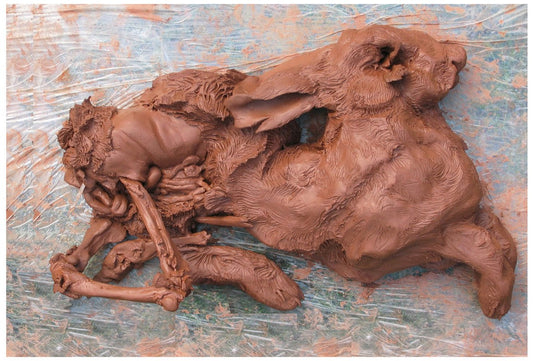Few historical artists could hold the award for Most Horrific Paintings longer than Francisco Goya. Francisco Goya was a painter and printmaker during Spain’s Romanticism and Rococo periods. His most renowned collection, dubbed the Black Paintings, was discovered along the walls of his home after the artist’s death. The works are over 200 years old, but no exact date is known for the completion of the paintings because Goya never dated or even signed them.
With the display of the Black Paintings came the hyper fixation from the public eye and critics alike to Saturn Devouring His Son. The painting stems from stories in Greek mythology regarding Saturn’s (Greek name Kronos) fate as both kings of the gods and as a father. Most depictions of the scene explore Saturn’s attempt to cheat fate by devouring his children to minimize the risk of losing power. With this tone of power-hungry dominance, like in Peter Paul Rubens’ depiction of the story, Saturn appears all-powerful and in control of his fate.
Francisco Goya diverged from this perspective; he certainly didn’t depict Saturn swallowing his children whole. There’s a gruesomeness to the scene, with the blood of Saturn’s children smeared across his lips and beard as it flows from his victim. The sockets of his child’s limbs became craters of Saturn’s prophecy; that one day, his own progeny would dethrone him. Goya chooses to replace the polished renaissance look of the gods with a macabre predator/prey relationship.

This theory focuses on what is directly in front of people—deranged artworks painted along the walls of his own home. Historians point to his experience in the Peninsular war as the gruesome inspiration behind the series. He witnessed and sketched the animosity of warfare while highlighting that even in these moments of despair, the cruel and unrelenting passage of time persists—leaving more corpses, yes, but eventually an ending.
It’s also important to remember that when he painted these works, he was in geriatric exile. He was 73 years old, and, by historical standards, he had one foot in the grave. He was almost entirely deaf. The Spanish royal court rejected him after painting for them for decades. With all this culminating, he was about as alone with his thoughts as anyone could be at the end of his life. With so few interruptions from his work and his mind, he could paint some of the most horrific paintings to date along the walls of his own home without a peep from what was considered to be his inner circle.
Some historians and scholars believe the opposite, emphasizing humor and optimism shining through in his works, highlighting a humorful older man with a satirical side in his paintings. Manuela Mena, the senior curator and in-house expert for Museo Nacional del Prado, said, “he was actually an optimist with a great sense of humor, very rational and very clear in his mind, right to the end of his life.”
During the 19th century, Spain became enamored with graphic surrealism in art, as these pieces touched on themes that typically weren’t commonly talked about. Not even Disney could put a PG spin on the symbolism in these paintings, even if the symbols themselves are still debated to this day.
At the same time, after looking at his mental state at the end of his life and the historical context of the pieces, nobody can honestly say they know and understand their meaning. Whether you love art for the bigger picture or the finer details, one thing is clear: hyper-fixating on every brush stroke of these paintings seems to be missing the point of his life as an artist.

Historians today still struggle with fitting Goya into our current labels for artists during the 19th century and even by 21st-century standards. Maybe the whole point was not to be part of the status quo, quietly creating a counterculture of his own in the comfort of his own walls toward the end of his life, which is still only almost as metal as the paintings themselves. Even still, would you want your brain picked apart from beyond the grave?
Francisco Goya died in 1828, merely five years after creating the Black Paintings. Analysis can help the world learn more about Goya and Spanish history at the time of these paintings’ creation. However, analyzing his artwork and his history with a 21st-century historical lens will only bring us farther from their reality.
©ArtRKL™️ LLC 2021-2023. All rights reserved. This material may not be published, broadcast, rewritten or redistributed. ArtRKL™️ and its underscore design indicate trademarks of ArtRKL™️ LLC and its subsidiaries.





